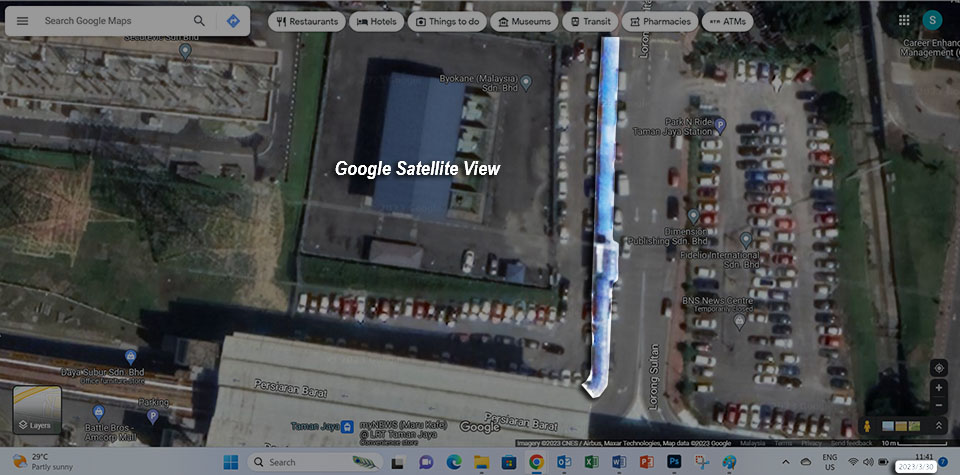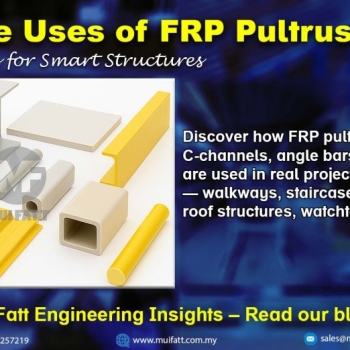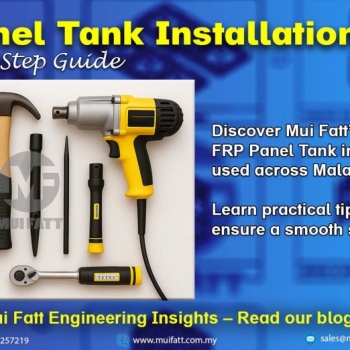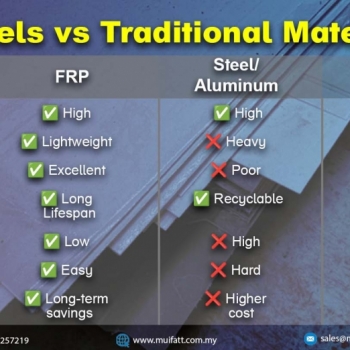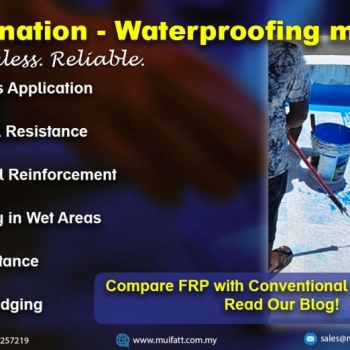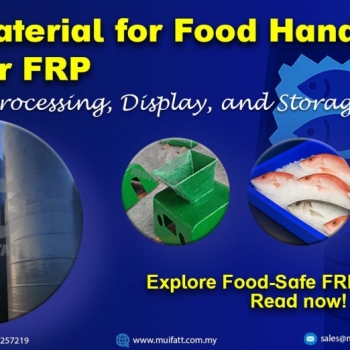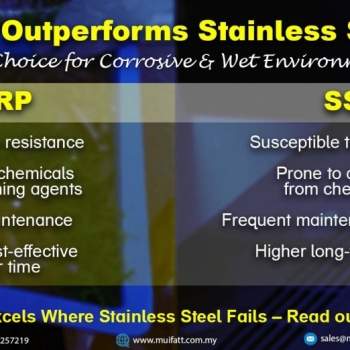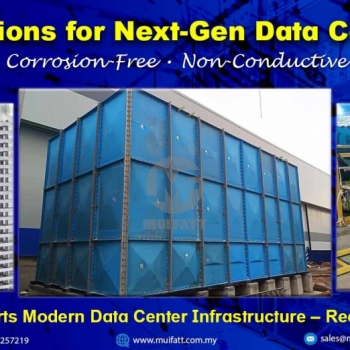FRP pultruded profiles are reshaping structural possibilities across Malaysia. From STP staircases to public park shelters, explore how these modular components enable custom FRP solutions—only from Mui Fatt.
Why FRP Structural Profiles Are the Best Choice for Walkways
30 Mar 2023
The Advantages of FRP Structural Profiles for Covered Walkways
- Key Takeaways
- Challenges of Mild Steel Walkways
- Why Choose FRP Structural Profiles for Walkways?
- Real-World Application: Taman Jaya LRT FRP Walkway
- Conclusion
- Frequently Asked Questions (FAQs)
Key Takeaways
-
FRP structural profiles are corrosion-resistant, making them ideal for outdoor and humid environments.
-
They are lightweight yet strong, simplifying installation and reducing overall structural load.
-
FRP requires minimal maintenance, lowering long-term costs.
-
Non-conductive properties make FRP the safest option near electrical installations.
-
Customizable designs allow for flexible and tailored walkway solutions.
-
Fire-retardant formulations enhance safety in high-risk areas.
Pedestrian walkways are essential for ensuring safe and convenient passage, especially in areas exposed to harsh weather conditions. Traditionally, mild steel has been the go-to material for walkway construction. However, advancements in material technology have introduced Fiberglass-Reinforced Plastic (FRP) structural profiles, which offer superior benefits in durability, safety, and cost-effectiveness.
Challenges of Mild Steel Walkways
Corrosion & Rust
Steel is highly susceptible to rust, especially in high-humidity environments, leading to frequent maintenance and eventual structural deterioration.
High Maintenance Costs
Regular painting, coating, and repairs are necessary to prolong the lifespan of steel walkways, adding to operational expenses.
Heavyweight Structure
Steel’s weight makes installation more challenging, requiring heavy lifting equipment and increasing labor costs.
Electrical Conductivity Risk
In areas near electrical substations, steel walkways pose potential hazards such as electric shocks and arc flashes.
Additional Reads: Electrical Hazards of Steel Walkways
Why Choose FRP Structural Profiles for Walkways?
Corrosion Resistance
FRP does not rust or corrode, making it ideal for outdoor applications and environments with high moisture and chemical exposure.
Lightweight Yet Strong
FRP profiles are significantly lighter than steel while maintaining high load-bearing capabilities, simplifying installation and reducing structural load.
Low Maintenance
Unlike steel, FRP requires minimal upkeep, eliminating the need for frequent repainting or corrosion treatment.
Non-Conductive & Safe
FRP is an electrically non-conductive material, making it the safest choice for walkways near electrical substations and power grids.
Customizable & Flexible Design
FRP can be molded into various shapes and sizes to suit different applications, offering greater design flexibility.
Fire Retardant Properties
FRP composites can be formulated with fire-retardant additives to enhance safety in high-risk areas. These additives work in different ways to slow down the combustion process and reduce the spread of flames.
Real-World Application: Taman Jaya LRT FRP Walkway
One of our best examples of FRP walkway implementation is at the Taman Jaya LRT Station, where an FRP pedestrian walkway was installed next to an electrical substation. This project highlights the long-term durability and safety benefits of FRP in high-risk environments.
Discover how our FRP structural profiles were successfully implemented at the Taman Jaya LRT Station to enhance safety and durability. Read the full project reference here - Project References - Taman Jaya LRT Station FRP Walkway | Safe & Durable
Fiberglass-Reinforced Plastic (FRP) walkway at Taman Jaya LRT station was installed almost a decade ago and still stands today.
Conclusion
FRP structural profiles are transforming walkway construction by offering a durable, lightweight, and corrosion-resistant solution. Their non-conductive nature makes them particularly beneficial for walkways near electrical installations. If you’re looking for a safe and long-lasting walkway solution, FRP is the way forward! Contact us today to discuss your walkway project – WhatsApp or email at sales@muifatt.com.my.
Explore more about our FRP structural profiles - FRP Structural Profiles Page
Frequently Asked Questions (FAQs)
What are FRP structural profiles made of?
FRP structural profiles are made from high-strength fiberglass reinforcements combined with a resin matrix, ensuring exceptional durability, corrosion resistance, and long-term performance. These profiles are produced using the FRP pultrusion process, a continuous manufacturing method that creates strong, lightweight, and consistent structural components.
Want to learn more about how FRP structural profiles are made? Discover the strength and efficiency of the FRP pultrusion process in our detailed guide: The FRP Pultrusion Process: A Guide to Strength & Efficiency
How does FRP compare to steel in terms of weight and strength?
FRP is significantly lighter than steel, making installation easier while maintaining high load-bearing capabilities.
Are FRP walkways more expensive than steel walkways?
While initial costs may be comparable, FRP reduces long-term expenses due to its low maintenance and extended lifespan.
Can FRP structural profiles be customized?
Yes, FRP profiles can be tailored to different shapes and sizes based on project requirements.
Where can FRP walkway roofing and supports be used?
FRP walkways are ideal for public pedestrian walkways, industrial facilities, chemical plants, coastal areas, and electrical substations.
#FRPvssteel #NonrustSteelWalkway #SteelWalkway #FRPadvantages #FRPapplications #FRPwalkwayroofing #FRPstructuralprofiles #FRPtrusses #FRPpurlins #corrosionresistantwalkways #lightweightFRP #nonconductiveFRP #durablewalkwaymaterials
Additional reads:
A steel walkway located beside an electrical station can present several electrical hazards. These hazards can be caused by exposed or improperly grounded electrical components.
The most significant hazard is electric shock, which can occur if someone comes into contact with an exposed live wire or electrical component. In some cases, electric shock can be fatal. Another hazard is arc flash, which occurs when there is an electrical fault or short circuit. This can produce a bright flash of light, intense heat, and pressure waves that can cause burns, hearing loss, and other injuries.
To prevent electrical hazards on a steel walkway located beside an electrical station, several safety measures should be taken. The walkway should be designed and constructed to meet safety standards and regulations, which includes ensuring that the walkway is properly grounded and that all electrical components are covered or shielded to prevent accidental contact. Alternatively, alternative materials such as Fiberglass-Reinforced Plastic (FRP) could be used to eliminate all the potential safety hazards associated with steel walkways next to electrical stations.
Disclaimer:-
The information provided on this website is for general informational purposes only and does not constitute legal advice. While we strive to ensure the accuracy and reliability of the information provided, we make no representations or warranties of any kind, express or implied, about the completeness, accuracy, reliability, suitability, or availability concerning the information contained herein. Any reliance you place on such information is therefore strictly at your own risk. This website may contain links to other third-party websites. Such links are only for the convenience of the reader, user, or browser; which we do not warrant, recommend, endorse, or assume liability for the contents of the third-party sites.
Keep in touch with us should you be keen on receiving timely updates from us
- Website - https://www.muifatt.com.my/home/
- Facebook - https://www.facebook.com/muifattmarketing
- Instagram - https://www.instagram.com/muifattmarketing/
- Google - https://goo.gl/maps/WxVY13gNcaRTS7Jp6
- Youtube - http://www.youtube.com/@MuiFattMarketing
- TikTok - https://www.tiktok.com/@muifattmarketing
- LinkedIn - https://www.linkedin.com/company/mui-fatt-marketing-sdn-bhd-
- Linktree - https://linktr.ee/muifattmarketing
- Shopee - https://www.shopee.com.my/muifattmarketing
- Lazada - https://www.lazada.com.my/shop/mui-fatt-marketing
Recent Blog
Mui Fatt Engineering Insights - FRP Panel Tank Installation
Get to know the step-by-step assembly process of FRP sectional panel tanks, based on Mui Fatt’s industry-proven practices. This easy-to-digest guide is ideal for project managers, contractors, and technical personnel involved in water storage tank installation across Malaysia.
FRP Panels vs Traditional Alternatives: The Ultimate Guide to Durability and Sustainability
Explore why FRP (Fiberglass-Reinforced Plastic) panels outperform traditional materials like steel, plywood, and PVC in durability, sustainability, and cost-effectiveness. Discover real-world applications in MyKiosk projects and cold truck panel assembly, where FRP’s superior insulation, corrosion resistance, and lightweight properties deliver long-term benefits.
Comparing FRP Waterproofing with Traditional Systems
Is FRP lamination a better waterproofing method than traditional systems? Explore this complete guide with real project examples and see why FRP is gaining traction across Malaysia.
Benefits of FRP in Food Handling & Processing
With hygiene, durability, and corrosion resistance at its core, FRP (Fibreglass Reinforced Plastic) is becoming a preferred material in the food industry. This article explores why FRP is ideal for food handling equipment such as supermarket fish trays, water tanks, and food factory platforms, plus how Mui Fatt is delivering proven solutions through its successful FRP applications.
Mui Fatt Insights: Advanced Materials for Modern Needs
Is stainless steel the best for wet areas? This article explains why more industries are switching to FRP for its corrosion resistance, hygiene benefits, and longevity, especially in food displays and chemical exposure zones.
How FRP Supports Modern Data Center Infrastructure
Discover how fiberglass-reinforced plastic (FRP) is reshaping data center construction. Learn its key advantages, comparisons with other materials, and where to apply FRP—from rooftop chillers to cooling tanks.
Understanding FRP Filament Winding: Process, Benefits & Comparison
This article explores the FRP filament winding manufacturing method, how it differs from other FRP techniques, why it’s still widely used, and its long-term value for projects like high-strength tanks and cylinders.
